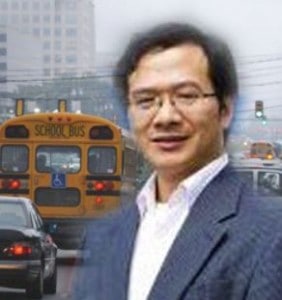 Forget about gas, the roads in American have bumps and potholes. Wouldn’t it be nice if we could get a jump-start on energy from the bumps in the road?
Forget about gas, the roads in American have bumps and potholes. Wouldn’t it be nice if we could get a jump-start on energy from the bumps in the road?
Lei Zuo, an associate professor of mechanical engineering in Virginia Tech’s College of Engineering, is developing a way to harvest energy from the car’s suspension taking the motion from going over bumps or holes and turning it into electrical power. Zuo is researching ways to use the vibrational energy dampened by the shock absorbers.
Zuo estimates that a car’s shock absorbers should be able to provide between 100 and 400 watts of energy on normal roads and even more on rougher roads, increasing fuel efficiency between 1 and 5 percent, which would add up to an annual fuel savings of $13 billion to $19 billion.
His energy-harvesting shock absorber works by translating the vertical vibrations of the suspension into rotational motion that turns a generator. The generator delivers electricity directly to the car’s battery or electrical devices, reducing the demand on the alternator.
This system has solved a major challenge in harvesting vibrational energy— converting bidirectional, up-and-down motion into the unidirectional motion needed to drive a generator. A unique combination of gears allows motion in both directions to be converted into electricity, essentially doubling the amount of energy that can be recovered. The generator works at a steady speed and reduces the load on the gear teeth, making the system more efficient and reliable. On top of that, the generator keeps rotating even after the vibration has stopped, maximizing the amount of energy recovered.
He and his students have tested the shock absorber on campus roads. Their current model, built using off-the-shelf components, can harvest about 60 percent of the available energy. Zuo believes that with precision components and manufacturing the system could reach 85 percent efficiency.
For late-model cars, the device is entirely retrofittable and can be integrated in the car directly without changing anything in the car. Zuo and his team have created other types of energy-harvesting shock absorbers, including linear electromagnetic and hydroelectric absorbers.
Zuo, who recently received an award for this work from the Governor’s Commonwealth of Virginia Research Commercialization Fund, plans to focus next on the commercial viability of the energy-harvesting system. Zuo is focusing on applications for large commercial vehicles while working to reduce the cost.
To improve performance, Zuo said he wants to adapt his design using a strategy called self-powered semi-active control: A microprocessor senses vehicle conditions and adjusts the suspension settings accordingly, delivering the smoothest ride while harvesting the greatest amount of energy.
Zuo is the associate director of the Virginia Tech Center for Energy-Harvesting Materials and Systems